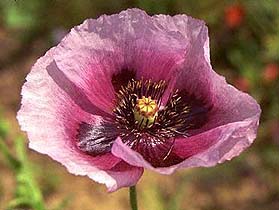Poppy
Papaver somniferum Its name comes from Roman times: pappo- meaning “to eat” and -verum–“real”. The second part comes from the common practice in the past to add poppy to children’s food so as to put them to sleep: somniferum means “bringing sleep”, “soporific”. |
The poppy is the oldest intoxicating plant in the human history. The plant is an annual, about 1.5 m high. It has white, pink or violet blossoms, and a specific unpleasant smell. Its every part, except for the seeds, contains a white milky resinous liquid, which is, in fact, the raw opium. It is gathered from the plant early in the mourning, kneaded into small flat loaves and then dried.
The native
land of the plant is supposed to be Asia but pictures of poppy have been
found on the islands of Crete, dating back to the ancient Greek culture.
It is also on the list of medicinal plants in an Egyptian papyrus from
1500 BC. |
|
Turkish warriors always went to battle intoxicated and nothing could stop them. The plant was also popular in India, Taiwan and later in China, where more than 120 million people needed opium in 1878. The desire for tranquility and sweet dreams over and over again led to numerous poisonings. At first, sleepiness appeared, followed by weakness, contracted eye pupils, lower body temperature, and faint breathing. If the dose is high, all this will result in coma.This lasted until 1805 when a German pharmacist extracted an alkaloid and named it after the Greek god of sleep Morphaeus. It was the first alkaloid which possesses narcotic properties. Morphine is one of the strongest painkillers ever knownâa soporific tranquilizer. One who has taken morphine forgets all about hunger, fatigue, grief, and fear. The poison has turned to a medicine but a medicine can also turn to poison. Morphine saves patients from pain but not from the disease, so they need more and more morphine. The symptoms of poisoning are nausea, vomiting and depression. Then come dizziness, dry mouth, breathing disruptions and decreased blood pressure, usually with an unfortunate end. Anyway, millions of people in the whole world still find relief from the pain in this poisonous cure, morphine.
Later, scientists found more than 20 other alkaloids in the opium. The most important ones are codeine and papaverinum. Codeine is a common ingredient of medicines against cough, whereas papaverinum is a popular painkiller of stomachache; it also controls blood vessel spasms.
Morphine played another big, yet evil, part in human historyâit is the âfatherâ of heroine (the name is a derivative of hero), the implacable addictive poison of our century created by the German pharmacist H. Dreser working for Bayer. A notoriously bad invention that has lead to many addictions and many deaths!

